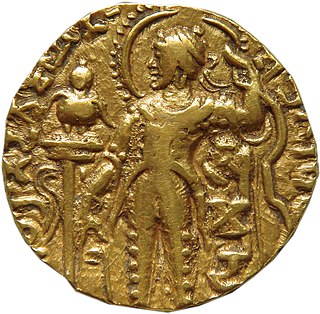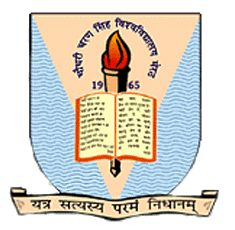Related Research Articles

Uttar Pradesh is a state in northern India. With over 241 million inhabitants, it is the most populated state in India as well as the most populous country subdivision in the world – more populous than all but four other countries outside of India – and accounting for 16.5 per cent of the population of India or around 3 per cent of the total world population. The state is bordered by Rajasthan to the west, Haryana, Himachal Pradesh and Delhi to the northwest, Uttarakhand and Nepal to the north, Bihar to the east, Madhya Pradesh, Chhattisgarh and Jharkhand to the south. It is the fourth-largest Indian state by area covering 243,286 km2 (93,933 sq mi), equal to 7.3 per cent of the total area of India. Lucknow serves as the state capital, with Prayagraj being the judicial capital. It is divided into 18 divisions and 75 districts. On 9 November 2000, a new state, Uttaranchal, was created from Uttar Pradesh's western Himalayan hill region. The two major rivers of the state, the Ganges and its tributary Yamuna, meet at the Triveni Sangam in Prayagraj, a Hindu pilgrimage site. Other notable rivers are Gomti and Saryu. The forest cover in the state is 6.1 per cent of the state's geographical area. The cultivable area is 82 per cent of the total geographical area, and the net area sown is 68.5 per cent of the cultivable area.

The Samajwadi Party is a socialist political party in India. It was founded on 4 October 1992 by former Janata Dal politician Mulayam Singh Yadav and is headquartered in New Delhi. The Samajwadi Party is currently led by former Chief Minister of Uttar Pradesh, Akhilesh Yadav. As of 2024, it is currently the third-largest political party in India, and the largest party in Uttar Pradesh.
The Karamnasa or Karmanasa River is a tributary of the Ganges. It originates in Kaimur district of Bihar and flows through the Indian states of Uttar Pradesh and Bihar. Along the boundary between Uttar Pradesh and Bihar it has the districts of Sonbhadra, Chandauli, Varanasi and Ghazipur on its left ; and the districts of Kaimur and Buxar on its right.

Hastinapur is a city in the Meerut district in the Indian state of Uttar Pradesh. Hastinapura, described in Hindu texts such as the Mahabharata and the Puranas as the capital of the Kuru Kingdom, is also mentioned in ancient Jain texts. Hastinapur is located on the right bank of the Ganga river.

The Archaeological Survey of India (ASI) is an Indian government agency that is responsible for archaeological research and the conservation and preservation of cultural historical monuments in the country. It was founded in 1861 by Alexander Cunningham during the British Raj who also became its first Director-General.

The history of metallurgy in the Indian subcontinent began prior to the 3rd millennium BCE. Metals and related concepts were mentioned in various early Vedic age texts. The Rigveda already uses the Sanskrit term ayas. The Indian cultural and commercial contacts with the Near East and the Greco-Roman world enabled an exchange of metallurgic sciences. The advent of the Mughals further improved the established tradition of metallurgy and metal working in India. During the period of British rule in India, the metalworking industry in India stagnated due to various colonial policies, though efforts by industrialists led to the industry's revival during the 19th century.

Nirbhay Singh Gurjar was an Indian criminal and one of the last dacoits of the Chambal. He terrorized the Chambal ravines in India, the lawless zone at the cusp of two states Uttar Pradesh and Madhya Pradesh for 31 years.

Black and red ware (BRW) is a South Asian earthenware, associated with the neolithic phase, Harappa, Bronze Age India, Iron Age India, the megalithic and the early historical period. Although it is sometimes called an archaeological culture, the spread in space and time and the differences in style and make are such that the ware must have been made by several cultures.

The Painted Grey Ware culture (PGW) is an Iron Age Indo-Aryan culture of the western Gangetic plain and the Ghaggar-Hakra valley in the Indian subcontinent, conventionally dated c.1200 to 600–500 BCE, or from 1300 to 500–300 BCE. It is a successor of the Cemetery H culture and Black and red ware culture (BRW) within this region, and contemporary with the continuation of the BRW culture in the eastern Gangetic plain and Central India.

The Northern Black Polished Ware culture is an urban Iron Age Indian culture of the Indian subcontinent, lasting c. 700–200 BCE, succeeding the Painted Grey Ware culture and Black and red ware culture. It developed beginning around 700 BCE, in the late Vedic period, and peaked from c. 500–300 BCE, coinciding with the emergence of 16 great states or Mahajanapadas in Northern India, and the subsequent rise of the Mauryan Empire.
Tiwari, from Sanskrit 'tripāṭhin', is a Hindu surname found in India and Nepal. Alternative spellings include Tiwary and Tewari.

In the prehistory of the Indian subcontinent, the Iron Age succeeded Bronze Age India and partly corresponds with the megalithic cultures of India. Other Iron Age archaeological cultures of India were the Painted Grey Ware culture and the Northern Black Polished Ware. This corresponds to the transition of the Janapadas or principalities of the Vedic period to the sixteen Mahajanapadas or region-states of the early historic period, culminating in the emergence of the Maurya Empire towards the end of the period.

The South Asian Stone Age covers the Palaeolithic, Mesolithic and Neolithic periods in the Indian subcontinent. Evidence for the most ancient Homo sapiens in South Asia has been found in the cave sites of Cudappah of India, Batadombalena and Belilena in Sri Lanka. In Mehrgarh, in western Pakistan, the Neolithic began c. 7000 BCE and lasted until 3300 BCE and the Chalcolithic and early Bronze Age. In South India, the Mesolithic period lasted until 3000 BCE, and the Neolithic period until c. 1000 BCE, followed by a Megalithic transitional period, mostly skipping the Bronze Age. The Iron Age in India began roughly simultaneously in North and South India, around c. 1200 to 1000 BCE.

Kalyan Singh was an Indian politician and a member of the Bharatiya Janata Party (BJP). He served twice as the Chief Minister of Uttar Pradesh and as a Member of Parliament. He was the Chief minister of Uttar Pradesh during the demolition of the Babri Masjid in December 1992. He is considered an icon of Hindu nationalism, and of the agitation to build a Ram temple in Ayodhya.

Akhilesh Yadav is an Indian politician and national president of the Samajwadi Party who served as the 20th Chief Minister of Uttar Pradesh. Having assumed the chief minister's office on 15 March 2012 at the age of 38, he is the youngest person to have held the office till date. He is the incumbent Member of Parliament for Kannauj in the 18th Lok Sabha. He is the parliamentary party leader of Samajwadi Party in 18th Lok Sabha. Earlier, he was an elected as the Member of Legislative Assembly for Karhal in the 18th Vidhan Sabha, before resigning and has also been the Leader of Opposition in the Uttar Pradesh Legislative Assembly from March 2022 to June 2024.

Chaudhary Charan Singh University, formerly Meerut University, is a public state university located in Meerut, Uttar Pradesh, India. The university was established in 1965. It was later renamed to its current name after Chaudhary Charan Singh, former Prime minister of India. The university celebrated its silver jubilee in 1991.

Sanjay Gandhi Postgraduate Institute of Medical Sciences (SGPGI) is a medical Institute under the State Legislature Act in Lucknow, Uttar Pradesh, 14 km (8.7 mi) south of Hazratganj on Raebareli Road. It was established in 1983 and is named after Sanjay Gandhi.

The Uttar Pradesh Police, is the primary law enforcement agency within the Uttar Pradesh state of India. Established in 1863 as the Office of the Inspector General of Police, United Provinces under the Police Act, 1861.
Lahuradewa is located in Sant Kabir Nagar District, in Sarayupar (Trans-Sarayu) region of the Upper Gangetic Plain in Uttar Pradesh state of India. The Sarayupar Plain is bounded by the Sarayu river in the west and south, Nepalese Terai in the north, and the Gandak River in the east.
Rakesh Yadav is a cardiologist and a professor working at All India Institute of Medical Sciences, New Delhi.
References
- ↑ "Pre-historic camping site found in Ladakh". The Hindu. 4 December 2016. Retrieved 18 March 2018.
- ↑ "Ayodhya verdict: Ex-ASI director's 'work' on disputed site may have proved crucial". Hindustan Times. 14 November 2019. Retrieved 18 March 2021.
- ↑ "Human beings have been the biggest threat to rock art sites: Dr Rakesh Tewari, former DG of ASI talks to Free Press". Free Press Journal. 28 February 2020. Retrieved 18 March 2021.
- ↑ "Archived copy" (PDF). Archived from the original (PDF) on 12 July 2015. Retrieved 11 July 2015.
{{cite web}}: CS1 maint: archived copy as title (link) - ↑ "Disgruntled lot digs dirt on ASI chief's appointment". The New Indian Express. Archived from the original on 27 October 2013. Retrieved 29 January 2018.